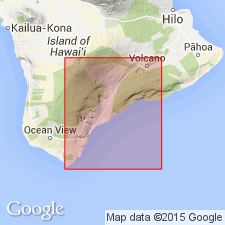
- Usage in publication:
-
- Uwekahuna ash
- Modifications:
-
- Original reference
- Dominant lithology:
-
- Ash
- AAPG geologic province:
-
- Hawaii
Summary:
Pg. 27-28. Uwekahuna ash. Ash bed in wall of Kilauea caldera. Thickness 1 inch to 7 feet. At northeast end of exposure, bed is 3 feet thick and consists of gravel and a few lava-coated bombs; beneath Uwekahuna intrusive body is 6.5 feet of ash having basal layer of medium-coarse black ash overlain by a second gravel stratum, and at top about 8 inches of yellow ash; at southwest end of exposure, ash bed lies on surface of unconformity in the lavas.
Type locality: west wall of Kilauea caldera at base of Uwekahuna cliff [Bluff] northeast of fault terraces, [Kilauea 7.5-min quadrangle], Island of Hawaii, HI. Named from Uwekahuna cliff [Bluff].
Another ash section (17 feet thick; described by Powers, 1916) was formerly exposed southwest of the fault terraces but was buried by lava flow of 1919 from Halemaumau.
Source: US geologic names lexicon (USGS Bull. 1200, p. 4038-4039).
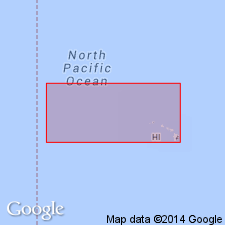
- Usage in publication:
-
- Uwekahuna formation
- Modifications:
-
- Age modified
- Redescribed
- AAPG geologic province:
-
- Hawaii
Summary:
Uwekahuna Ash of Stone (1926) called Uwekahuna Formation. Erupted before Kilauea caldera assumed present form. Age estimated at 15,000 yr B.P.
Source: GNU records (USGS DDS-6; Menlo GNULEX).
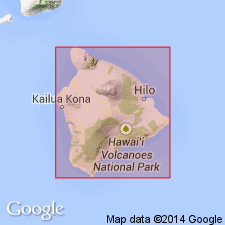
- Usage in publication:
-
- Uwekahuna tuff
- Modifications:
-
- Redescribed
- AAPG geologic province:
-
- Hawaii
Summary:
Calls Uwekahuna formation "Uwekahuna tuff". Unit is considered to be remnant deposits of five epochs of intense lava fountaining or magmatic explosion. Measured section is described on northwestern Kilauea crater wall and at tree mold locality one-third mi northwest of crater.
Source: GNU records (USGS DDS-6; Menlo GNULEX).
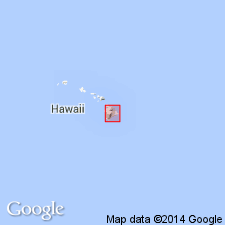
- Usage in publication:
-
- Uwekahuna ash*
- Modifications:
-
- Areal extent
- Adopted
- AAPG geologic province:
-
- Hawaii
Summary:
Pg. 65, 67-68. Uwekahuna ash [unit] of Puna volcanic series adopted. Exposed for more than 4,000 feet in lower part of western wall of Kilauea caldera. Measured section 50 feet north of Uwekahuna fault blocks described. Age is Recent.
Source: US geologic names lexicon (USGS Bull. 1200, p. 4038-4039); GNU records (USGS DDS-6; Menlo GNULEX).
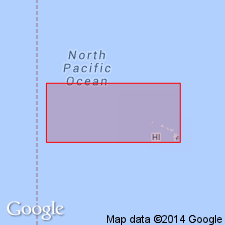
- Usage in publication:
-
- Uwekahuna ash*
- Modifications:
-
- Age modified
- AAPG geologic province:
-
- Hawaii
Summary:
"Interbedded with lavas of the Puna volcanic series; at its south end it mantles an unconformity within the series" [evidently unit not part of series here?] No fossils. Age changed to Pleistocene or Recent [no basis given]
Source: GNU records (USGS DDS-6; Menlo GNULEX).
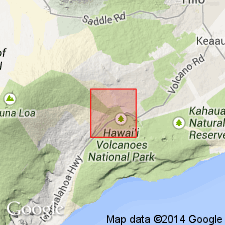
- Usage in publication:
-
- Uwekahuna ash*
- Modifications:
-
- Mapped
- AAPG geologic province:
-
- Hawaii
Summary:
Location shown on map of Kilauea Crater 7.5' quad, Island of Hawaii at base of northwestern wall of Kilauea caldera. Age given as Quaternary ("prehistoric rock unit').
Source: GNU records (USGS DDS-6; Menlo GNULEX).
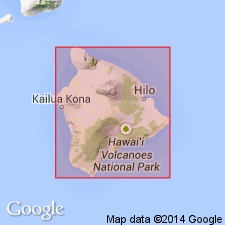
- Usage in publication:
-
- Uwekahuna Member
- Modifications:
-
- Revised
- Age modified
- AAPG geologic province:
-
- Hawaii
Summary:
Uwekahuna Ash (Stone, 1926) reduced in rank and renamed "Uwekahuna Member". Fig. 1 shows unit as lower member of Puna Formation. Age assigned is 5000 yr B.P.
Source: GNU records (USGS DDS-6; Menlo GNULEX).
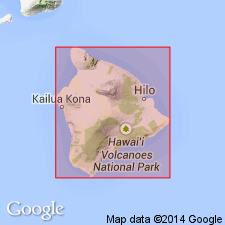
- Usage in publication:
-
- Uwekahuna Ash*
- Modifications:
-
- Geochronologic dating
- AAPG geologic province:
-
- Hawaii
Summary:
Carbon-14 ages on charcoal from overlying and underlying flows and on charcoal from lower part of Uwekahuna Ash near town of Volcano indicate 1500 yr B.P. for this episode of explosive eruption (Kelley and others, 1979; J.P. Lockwood, pers. commun., 1982). Carbonized material from pyroclastic deposits beneath the Uwekahuna Ash in another area near town of Volcano yields an age of about 2100 yr B.P.
Source: GNU records (USGS DDS-6; Menlo GNULEX).
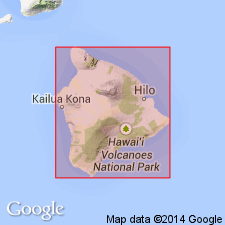
- Usage in publication:
-
- Uwekahuna Ash*
- Modifications:
-
- Geochronologic dating
- AAPG geologic province:
-
- Hawaii
Summary:
Carbon-14 ages on carbonized plant material range from 2,170 to 1,040 yr B.P.
Source: GNU records (USGS DDS-6; Menlo GNULEX).
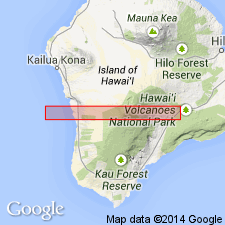
- Usage in publication:
-
- Uwekahuna Ash Member*
- Modifications:
-
- Overview
- AAPG geologic province:
-
- Hawaii
Summary:
Detailed section at Uwekahuna Bluff shows relationship of unit to Uwekahuna Ash member to Keanakakoi Ash Member (divided into Suites A-D). Uwekahuna Ash Member designated unit 43 (lying beneath unit 42 of Suite C) is 1.5 to 2.2 m thick. Flows 44 thru 51 of Suite C are ponded against Uwekahuna Ash Member. Beneath the unit 51 of Suite C, Uwekahuna Ash Member is 1.4 m thick where it overlies Suite D. Chronology of rock suites at Uwekahuna Bluff is traced. Eruption of Uwekahuna Ash Member is estimated at about 2.1 and 0.2 ka.
Source: GNU records (USGS DDS-6; Menlo GNULEX).
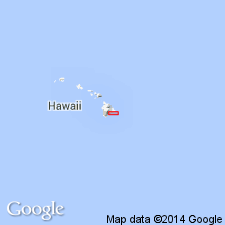
- Usage in publication:
-
- Uwekahuna Ash Member*
- Modifications:
-
- Redescribed
- AAPG geologic province:
-
- Hawaii
Summary:
Uwekahuna Ash Member of Puna Basalt. Renamed to indicate dominant lithology.
Type section: at Uwekahuna Bluff, Kilauea caldera [Lat. 19 deg. 25 min. 43 sec. N., Long. 155 deg. 17 min. 01 sec. W.], Kilauea Crater 7.5-min quadrangle, Island of Hawaii, HI.
Reference section: at Nanahu Arroyo, Hilina Pali, 0.5 km northeast of end of Hilina Pali [Trail], Lat. 19 deg. 18 min. 15 sec. N., Long. 155 deg. 18 min. 34 sec. W., Kau Desert 7.5-min quadrangle, Island of Hawaii, HI.
Source: Modified from GNU records (USGS DDS-6; Menlo GNULEX).
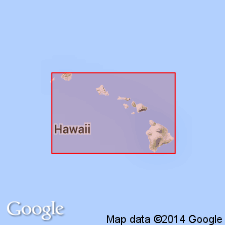
- Usage in publication:
-
- Uwekahuna Ash member*
- Modifications:
-
- Redescribed
- AAPG geologic province:
-
- Hawaii
Summary:
Uwekahuna Member of Puna Formation (Easton and Garcia, 1980) name changed to Uwekahuna Ash Member of Puna Basalt to indicate lithology. Composed mainly of pyroclastic surge deposits. Exposed near base of Kilauea Crater and on southeastern flank of Mauna Loa. Interbedded with prehistoric Puna lava flows. Assigned Holocene age. [see Easton, chapter 11; Holcomb, chapter 12; and Casadevall and Dzurisin, chapter 13, this volume]
Source: GNU records (USGS DDS-6; Menlo GNULEX).
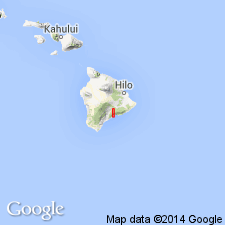
- Usage in publication:
-
- Uwekahuna Ash*
- Modifications:
-
- Revised
- AAPG geologic province:
-
- Hawaii
Summary:
Pg. 721+. Uwekahuna Ash. Formerly a member of Puna Basalt (Easton, 1987). Uwekahuna is revised and raised to formation rank; upper part includes Kulanaokuaiki Tephra Member (new). Only upper part exposed in Bluff-base section [former type] and entire unit is exposed in newly exhumed mid-Bluff section. Underlies, overlies, and interbedded with lava flows of Puna Basalt. Age is considered ca. 200 BC to AD 1000, based on radiocarbon ages and observed field relations.
Type section (revised): mid-Bluff section exposed north of Volcanic Observatory, in walls of hand-dug 3.12-m pit dug at top of talus apron and at base of steep caldera wall, approx. 30 m above present caldera floor (Lat. 19.42247 deg. N., Long. 155.28775 deg. W.; Old Hawaiin Datum), [west of Uwekahuna Bluff, northwest side of Kilauea Crater, Kau district], Hawaii Volcanoes National Park, Island of Hawaii. May be equivalent to Powers' (1916) 17-foot-thick (about 5 m) section that was buried by the lava flow of 1919.
Source: Publication.
For more information, please contact Nancy Stamm, Geologic Names Committee Secretary.
Asterisk (*) indicates published by U.S. Geological Survey authors.
"No current usage" (†) implies that a name has been abandoned or has fallen into disuse. Former usage and, if known, replacement name given in parentheses ( ).
Slash (/) indicates name conflicts with nomenclatural guidelines (CSN, 1933; ACSN, 1961, 1970; NACSN, 1983, 2005, 2021). May be explained within brackets ([ ]).

